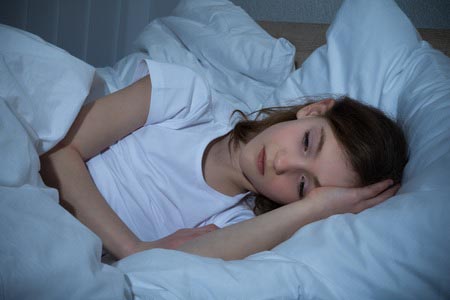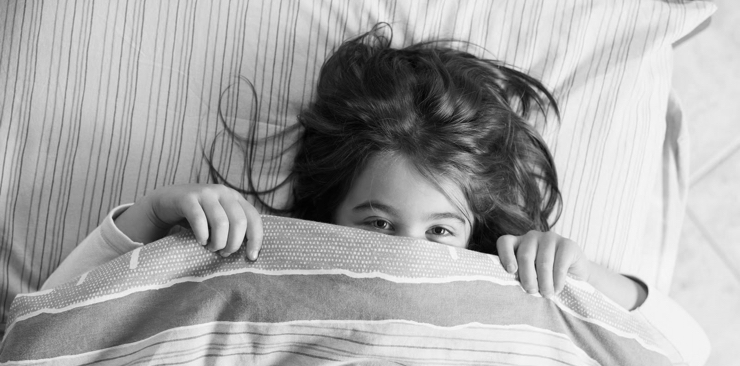Nighttime fears are very common, with nearly two-thirds (64.2%) of children and adolescents reporting nighttime fears. These types of fears are normal reactions to real or imagined threats at night, and have been cited in the medical, psychiatric and normative fear literature since the time of Hippocrates in 460-370BC. Such nocturnal fears cover a broader content than solely a fear of darkness, including fears of bad dreams, nightmares, noises, shadows, monsters, intruders, burglars, kidnappers, and of being left alone at night. Nighttime fears concerning “environmental threats” (e.g. inside or outside noises), “personal security,” and “frightening dreams” typically occur the most frequently.
Children likely differ from adolescents in that their nighttime fear pattern includes more fears related to “personal security,” “frightening dreams,” “imaginary creatures,” and “animals and insects.” Most children and adolescents seem to overcome or outgrow nighttime fears; however, others experience persistent and severe nighttime fears that interfere with their daily functioning, and cause much distress for both the child/adolescent and family. Kids most likely cope with their nocturnal fears the best they can, employing strategies such as: “self-control/distraction” (e.g. ignoring or thinking of other things), “social support” (e.g. going to parents to talk to them), “clinging to inanimate objects” (e.g. hugging soft toys), “control over others” (e.g. asking parents for a drink), or “prayer.” Since almost 70% of children who experience nighttime fears tell their parents, how can you best be prepared to help your child overcome her fears and anxieties?
If your kids are telling you about their nocturnal fears, you know they need some help trying to control their emotional responses to them, as well as some assistance distinguishing appearances from reality. Additionally, your children might require help learning how to reason and trust rational conclusions over misleading noises or other sensory information (e.g. that bump on the floor might look like a monster, but I know it’s really clothes). The following is a helpful checklist for how to help your child calm down in the midst of a nighttime fear onset:
Be patient, understanding and listen
Try to understand your child’s fears. Don’t dismiss or make fun of them. Particularly if your child’s nighttime fears are depriving you of sleep, it’s normal to feel irritation or resentment. Try not to direct anger or frustration at your child because if she feels rejection, this might intensify her separation anxiety and worsen the nighttime fear.
Be a model of calm behavior and provide necessary reassurance

Teach coping skills
During the daytime, discuss your child’s fears and discuss how she can counteract them. Help your child practice several tactics, including thinking happy thoughts, telling herself that she is brave, rehearsing relaxing techniques and converting frightening imaginary creatures into something silly and non-threatening. You could also talk about how you deal with something that you are afraid of, and provide examples of coping role models by reading stories about children who are afraid and conquer their fears. Additionally, you can try role-playing where you show your child how to counter her nighttime fears, and then she tries each technique out herself. Then, the child could play the role of the comforting adult to either you or her favorite toy.
Avoid frightening television, stories, and imagery – especially before bedtime
Keep your child away from scary TV shows, videos or stories that may add to her fears. A 2006 study reported that five and six-year-olds exposed to adult TV programs, including the evening news, slept less overall and experienced more sleep disturbances.
Security object
Help your child become attached to a security object that she can keep in bed with her. This can help her feel more relaxed at bedtime and also throughout the night.
Consider a Nightlight
As you and your child work through her nighttime fears, it might be helpful to switch to progressively dimmer light. Find a nightlight that gives off soft, warm light, not a light with a blue cast, which may prevent the production of melatonin and cause your child to have trouble falling asleep. Another thing to try is leaving the bedroom door open so that your child doesn’t feel isolated from the rest of the family.
Show your child how to relax
For example, as you soothe your crying child, you can show her relaxing breathing exercises. In one study alone, breathing exercises were successful in reducing distress in 40% of kids experiencing anxiety. Along these lines, the Turnaround Anxiety “Chill” CD has great soothing exercises for kids to do for relaxation and to help reduce anxiety.
If your child suffers from severe nighttime fears, consult with a doctor or licensed therapist
Recent research suggests that kids with issues at night often suffer from a variety of problems during the day, including anxiety, impulsivity, and abnormal attention control, most likely. A specialist in your area can help recommend a treatment program that will be tailored to your child’s specific needs.
References:
Dewar, G. (2008). “Nighttime fears in children: a guide for the science-minded.” Parenting Science. Retrieved on December 17, 2014 from http://www.parentingscience.com/nighttime-fears.html
Gordon, J., King, N., Gullone, E., Muris, P., & Ollendick. T. (2007). “Nighttime fears of children and adolescents: Frequency, content, severity, harm expectations, disclosure, and coping behaviors.” Behaviour Research and Therapy, 45, 2464-2472.
Owens, J. A. & Mindell, J. A. (2005). Take Charge of Your Child’s Sleep: The All-in-One Resource for Solving Sleep Problems in Kids and Teens . New York: Marlowe and Co.


 Emily Powell Bass
Emily Powell Bass
[…] Read More […]